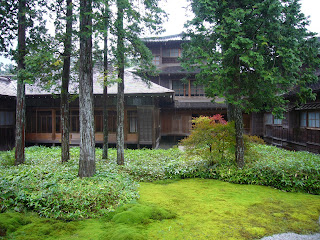 |
| Tokyo |
Our first day in Tokyo was taken up with an all day excursion to Mt Hakone where we were promised a view of Mt Fuji. This area is an old volcanic area where the volcano had burst its top many years before. Now the main vent is a malodorous area belching sulphurous fumes into the atmosphere. We braved the smell and even ate the eggs boiled in the heated pools, as they are meant to add 7 years to your life. We had a good view of Mt Fuji, hidden behind masses of clouds!
On the way back to Tokyo we had a problem with our train tickets. The pleasant inspector gathered them all together and took our guide to task over them. Once back at the station she was kept captive and we had to make our own way back to the hotel. We encountered some cultural confusion. We, of course, wanted to know what the problem was and what we could do to help. Our guide said that it was her 'shame' and we must not ask. She had obviously got something wrong but we weren't allowed to help fix it. We just hoped that she wasn't out of pocket over it.
The next day we hit Tokyo proper and visited the Asakusa district and the main shopping area of the Ginza. This latter district was the heart of Tokyo and the streets were lined with big department stores and all the designer label shops. It was a shopping mecca for clothes and electrical items, although the clothes were all geared to small Japanese sizes. The department stores all had big food sections on their ground floors and this was as good as David Jones's or Fortnum and Mason's. We also had the opportunity to attend one act of a kabuki play in the nearby theatre. People were queuing up outside and it was very popular but I have to confess that I was bored rigid. It was all in Japanese, as you would expect, but the 'action' was very static so once you had admired the costumes and the set there wasn't anything else to hold your interest. I was glad to get out and about again.
The next two days were spent whizzing around Tokyo and seeing the main sights including an Anime parlour, patrons lined up outside a Pachinko bar and the unusual sight of suited businessmen eating burgers at Macdonalds. I can't say that I warmed to Tokyo. It wasn't as busy and frenetic as I had believed and it wasn't as interesting as I expected. I much prefer Kyoto for the shopping and the cultural aspects of Japan. Would I go back to Japan? I would like to see Hokkaido but you would definitely need a smattering of Japanese to be able to successfully travel around the more rural areas by yourself. I definitely would not go if I had to sleep on the floor every night. I like a proper bed and my own bathroom! It was definitely an interesting experience!








